
Everyone Says I Love You is a 1996 American musical film written and directed by Woody Allen. It stars Allen, Alan Alda, Drew Barrymore, Goldie Hawn, Edward Norton, Natalie Portman, Julia Roberts and Tim Roth. Set in New York City, Venice and Paris, it features singing by actors not usually known for musical roles. The film was a commercial failure, but is among the more critically successful of Allen's films, with Chicago Sun-Times critic Roger Ebert even ranking it as one of Allen's best.

Eileen Evelyn Greer Garson was a British-American actress and singer. She was a major star at Metro-Goldwyn-Mayer who became popular during the Second World War for her portrayal of strong women on the homefront; listed by the Motion Picture Herald as one of America's top-10 box office draws from 1942 to 1946.
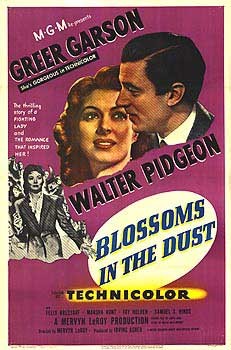
Blossoms in the Dust is a 1941 American biographical film directed by Mervyn LeRoy and starring Greer Garson, Walter Pidgeon, Felix Bressart, Marsha Hunt, Fay Holden and Samuel S. Hinds. It tells the story of Edna Gladney, who helped orphaned children find homes and began a campaign to remove the word "illegitimate" from Texas birth certificates, despite the opposition of "good" citizens. The screenplay was by Anita Loos, with a story by Ralph Wheelwright. Some of the important aspects of her life fictionalized in the film are the fact that it was Edna herself who was born out of wedlock; she and Sam eloped on the eve of her marriage to someone else, and they had much more time together before his death than given them in the film.

Random Harvest is a 1942 American romantic drama film based on the 1941 James Hilton novel of the same title, directed by Mervyn LeRoy. Claudine West, George Froeschel, and Arthur Wimperis adapted the novel for the screen, and received an Academy Award nomination. The novel keeps the true identity of Paula/Margaret a secret until the very end, something that would have been impossible in a film, where characters’ faces must be seen. This meant that the movie had to take a very different approach to the story. The film stars Ronald Colman as a shellshocked, amnesiac World War I veteran, and Greer Garson as his love interest.
Madame Curie is a 1943 American biographical film made by Metro-Goldwyn-Mayer. The film was directed by Mervyn LeRoy and produced by Sidney Franklin from a screenplay by Paul Osborn, Paul H. Rameau, and Aldous Huxley (uncredited), adapted from the biography by Ève Curie. It stars Greer Garson, Walter Pidgeon, with supporting performances by Robert Walker, Henry Travers, and Albert Bassermann.
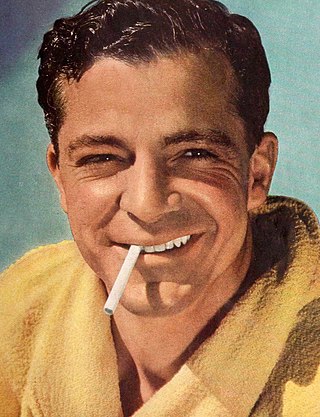
Carver Dana Andrews was an American film actor who became a major star in what is now known as film noir. A leading man during the 1940s, he continued acting in less prestigious roles and character parts into the 1980s. He is best known for his portrayal of obsessed police detective Mark McPherson in the noir Laura (1944) and his critically acclaimed performance as World War II veteran Fred Derry in The Best Years of Our Lives (1946).
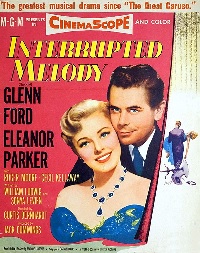
Interrupted Melody is a 1955 musical biopic film starring Eleanor Parker, Glenn Ford, Roger Moore, and Cecil Kellaway. Directed by Curtis Bernhardt, it was filmed in CinemaScope and Eastman Color, and produced for Metro-Goldwyn-Mayer by Jack Cummings. It tells the story of Australian soprano Marjorie Lawrence's rise to fame as an opera singer and her subsequent triumph over polio with her husband's help, from a screenplay by Lawrence, Sonya Levien, and William Ludwig. The operatic sequences were staged by Vladimir Rosing, and Eileen Farrell provided the singing voice for Parker.
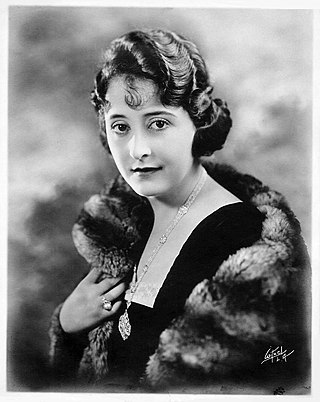
Clara Kimball Young was an American film actress who was popular in the early silent film era.
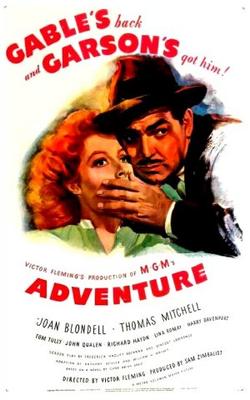
Adventure is a 1946 American romantic drama film directed by Victor Fleming and starring Clark Gable and Greer Garson. Based on the 1937 novel The Anointed by Clyde Brion Davis, the film is about a sailor who falls in love with a librarian. Adventure was Gable's first postwar film and the tagline repeated in the movie's famous trailer was "Gable's back and Garson's got him!" Gable had suggested "He put the arson in Garson," while Garson proposed "She put the able in Gable."
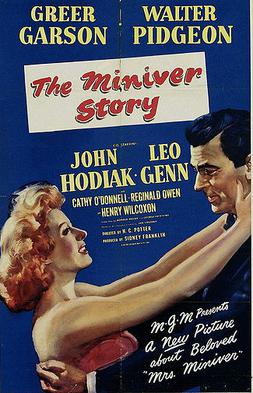
The Miniver Story is a 1950 American drama film that is the sequel to the 1942 film Mrs. Miniver. Like its predecessor, the picture, made by MGM, stars Greer Garson and Walter Pidgeon, but it was filmed on-location in England. The film was directed by H.C. Potter and produced by Sidney Franklin, from a screenplay by George Froeschel and Ronald Millar based on characters created by Jan Struther. The music score was by Miklós Rózsa and Herbert Stothart, with additional uncredited music by Daniele Amfitheatrof, and the cinematography by Joseph Ruttenberg.

A Man to Remember is a 1938 American drama film directed by Garson Kanin, his first film credit as a director. The picture was based on the short story Failure, written by Katharine Haviland-Taylor, and the screenplay was penned by Dalton Trumbo. The story tells of a saintly small-town doctor working under difficult circumstances somewhere in the United States after World War I. The movie is a remake of One Man's Journey (1933) starring Lionel Barrymore.
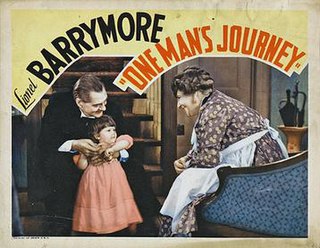
One Man's Journey is a 1933 American pre-Code drama film starring Lionel Barrymore as Dr. Eli Watt. The picture was based on the short story Failure written by Katharine Haviland-Taylor. It was remade by RKO as A Man to Remember (1938). The story tells of a small-town doctor working under difficult circumstances in a rural area somewhere in the United States.
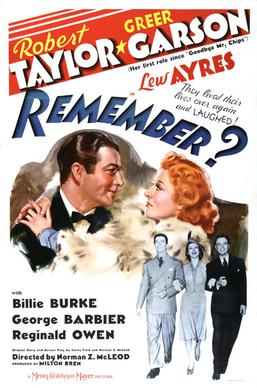
Remember? is an American romantic comedy released on December 19, 1939, directed by Norman Z. McLeod and starring Robert Taylor, Greer Garson and Lew Ayres. It was rushed into production by MGM studio chief Louis B. Mayer to capitalize on the attention and publicity generated by Greer Garson in her first film appearance, Goodbye Mr. Chips, released seven months earlier.

Julia Misbehaves is a 1948 American romantic comedy film starring Greer Garson and Walter Pidgeon as a married couple who are separated by the man's snobbish family. They meet again many years later, when the daughter whom the man has raised, played by Elizabeth Taylor, invites her mother to her wedding. The film also features Peter Lawford and Cesar Romero.
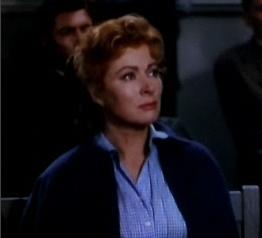
Scandal at Scourie is a 1953 American drama Technicolor film directed by Jean Negulesco, starring Greer Garson, Walter Pidgeon "above the title", and co-starring Donna Corcoran. Garson and Pidgeon were together for the 8th and last time in this movie, which was filmed on location in Canada.

Her Twelve Men is a 1954 American comedy drama film starring Oscar-winning Greer Garson and Robert Ryan, directed by Robert Z. Leonard, and written by William Roberts and Laura Z. Hobson. This MGM production was based on the best-selling pseudo-autobiographical book written by Louise Maxwell Baker, Snips and Snails. Baker herself taught at an all-boys boarding school, as the only female teacher in the school. Subsequently, Louise recounts many of the funny stories from her time as a teacher in Snips and Snails, which then translates into the film, Her Twelve Men.

The Law and the Lady is a 1951 American comedy film directed by Edwin H. Knopf and starring Greer Garson, Michael Wilding and Fernando Lamas. It is not related to the Wilkie Collins novel The Law and the Lady. Very loosely based on the 1925 play The Last of Mrs. Cheyney by Frederick Lonsdale, the action is transferred to the turn of the century, the names are all changed, and the first half of the film shows the history of the two thieves. Previous film versions of the story, made in 1929, starring Norma Shearer, and 1937, starring Joan Crawford, retained the play's contemporary setting, included a crew of confederates, and opened with Mrs. Cheyney as an established figure in society.. This film also ends differently from the play, with the partners in crime ending as romantic partners but going back to England to face the music for their very first swindle. In the play and in the two other films, Charles leaves and Mrs. Cheyney accepts Lord Dilling, who kisses her and declares: “That's the Last of Mrs. Cheyney!”
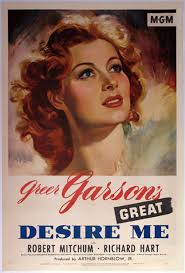
Desire Me is a 1947 American drama film starring Robert Mitchum and Greer Garson. It had a troubled production that included numerous directors and rewrites, and was ultimately released without a credited director.

The Lady in Scarlet is a 1935 American comedy drama film directed by Charles Lamont. It was made by Chesterfield Motion Pictures Corporation.
Half an Hour is a 1920 American silent drama film directed by Harley Knoles and written by Clara Beranger. The film stars Dorothy Dalton, Charles Richman, Albert L. Barrett, Frank Losee, and H. Cooper Cliffe. It is based on the 1913 play Half an Hour by J. M. Barrie. The film was released on September 19, 1920, by Paramount Pictures.

















